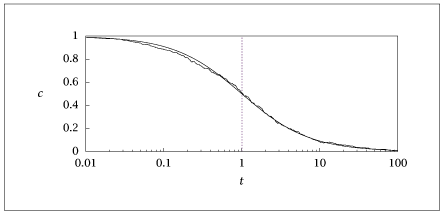import numpy as np
import matplotlib.pyplot as plt
omega = 500
k = 1
c0 = 1
n0 = int(c0 * omega)
nsim = 10 * omega
time = np.zeros(nsim + 1)
time[0] = 0
n = np.zeros(nsim + 1)
n[0] = n0
np.random.seed(10)
for i in range(nsim):
r = k * n[i] * (n[i] - 1) / (2 * omega)
if r == 0:
n = n[:i + 1]
time = time[:i + 1]
break
tau = -np.log(np.random.rand()) / r
time[i + 1] = time[i] + tau
n[i + 1] = n[i] - 2
nts = 500
tinit = 1e-2
tfin = 1e2
tc = np.logspace(np.log10(tinit), np.log10(tfin), nts)
c = 1 / (1 / c0 + k * tc)
xi = np.zeros(nts)
np.random.seed(0)
for i in range(nts - 1):
Delta = tc[i + 1] - tc[i]
xi[i + 1] = xi[i] - 2 * k * c[i] * xi[i] * Delta + np.sqrt(2 * k * c[i] * c[i] * Delta) * np.random.randn()
csde = c + xi / np.sqrt(omega)
plt.figure()
ts, ns = time, n
cs = ns / omega
plt.semilogx(ts, cs, label='kMC Simulation', base=10)
plt.semilogx(tc, c, label='Deterministic Solution', base=10)
plt.axis([tinit, tfin, 0, 1])
plt.legend()
plt.show(block=False)
plt.figure()
plt.semilogx(tc, csde, label='SDE Approximation', base=10)
plt.semilogx(tc, c, label='Deterministic Solution', base=10)
plt.axis([tinit, tfin, 0, 1])
plt.legend()
plt.show(block=False)
ts_ns_length = len(ts) - 1
tc_twice = np.tile(tc, 2)
c_twice = np.tile(c, 2)
csde_twice = np.tile(csde, 2)
data = np.column_stack((ts[:-1], cs[:-1], tc_twice[:ts_ns_length], c_twice[:ts_ns_length], csde_twice[:ts_ns_length]))
with open("sam2nd.dat", "w") as f:
np.savetxt(f, data, fmt='%f')
